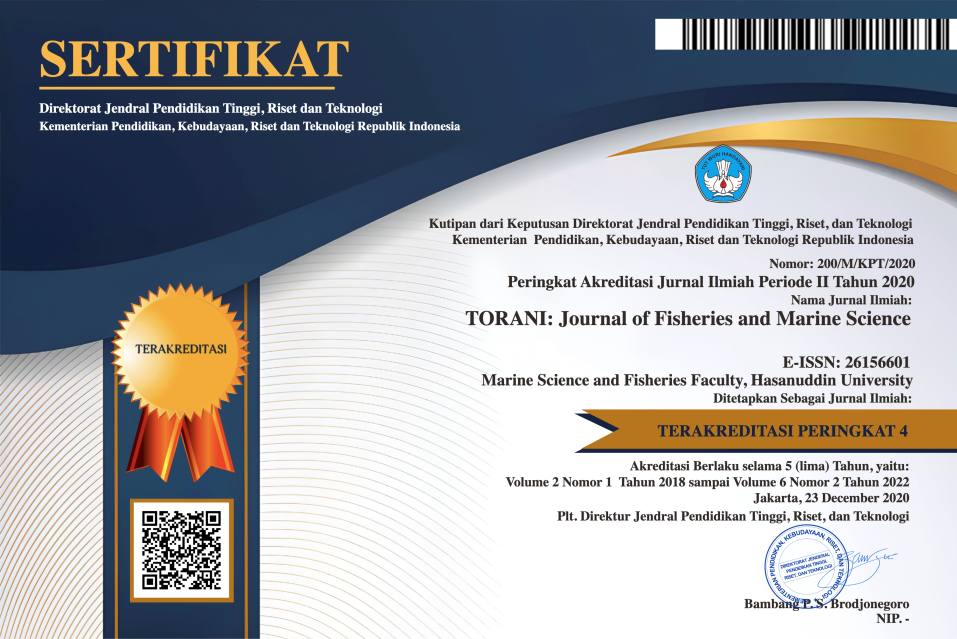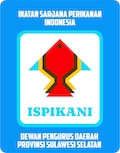Impact of sedimentation to sponge on coral reef ecosystems in Hoga and Sampela Island, Wakatobi Archipelago
DOI:
https://doi.org/10.35911/torani.v2i1.5854Abstract
Sponge is marine organism from porifera phylum which is a filter feeder (filtering food). Sponge can be degraded by high sediment suspended seawater, which causing a sponge body blockage, which will inhibit the growth of the sponge and even experienced death. This study aims to analyze the sponge coverage, sponge species identification and the relationship between sponge coverage and sedimentation rate. Underwater Photo Transect (UPT) was used in this study at three (3) depths i.e. 3 m, 6 m, and 10 m. The results showed that sponge coverage in high sedimentation rate is lower and there are 17 sponge species were found which were divided in to 14 family. In addition to sedimentation, water quality also greatly affects sponge coverage, such as currents, dissolved organic matter, salinity, and turbidity. One cause of sedimentation comes from the land, such as the transfer of land functions. Sponge's existence will continue to be threatened by physical and chemical pressure, and sedimentation if exploitation cannot be controlled.
Keywords: sponge, sedimentation, water quality, land change
References
Achmad. 2004. Sifat Fisik dan Kimia Air Laut. Gajah Mada University Press.Yogyakarta.
Amir, I dan budiyanto. 1996. Mengenal Sponge Laut (Demospongiae) Secara Umum. Oseana. Volume XXI, Nomor 2, 1996: 15-31
Bannister, R., Battershill, C., De Nys, R., 2012. Suspended sediment grain size and mineralogy across the continental shelf of the Great Barrier Reef: impacts on the physiology of a coral reef sponge. Cont. Shelf Res. 32, 86–95.
Bell., James., and Smith, D. 2004, Ecology of Sponge Assemblages (Porifera) in The Wakatobi Region, South East Sulawesi, Indonesia, Richness and Abundance, Jurnal Maritim.
Bell, J.J. & Barnes, D.K.A. 2000. A sponge diversity centre within a marine island. Hydrobiologia, 440,55^64.
Bond, C. & A. K. Haris. 1988. Locomotion of sponges and its physical mechanism. Journal of Experimental Zoology. 246: 271-284.
De Voogd, N.J.D. 2005. Indonesian sponges Biodiversity and marincultured potential, Geboren te Dodgrecht, Netherlands.
Duckworth, A. R. 2003. Effect of Wound Size on the Growth and Regeneration of Two Temperature Subtidal Sponge, Journal. EXP. Mar. Biol. Ecol, (287): 139 153.
Fettweis, M., Franckena, F., Van den Eyndea, D., Verwaestb, T., Janssensb, J., Van Lanckera, V., 2010. Storm influence on SPM concentrations in a coastal turbiditymaximum area with high anthropogenic impact (southern North Sea). Cont. Shelf Res. 30, 1417–1427.
Gerrodette, T., Flechsig, A. 1979. Sediment-induced reduction in the pumping rate of the tropical sponge Verongia lacunosa. Mar. Biol. 55, 103–110.
Haris. 2013. Komposisi Jenis dan Kepadatan Sponge (Porifera: Demospongiae) di Kepulauan Spermonde Kota Makassar. JIK-FIKP Unhas. Makassar.
Hutabarat, S. dan Evans, S.M. 1984. Pengantar Oseanografi. Universitas Indonesia Press. Jakarta
Kusnida, D., Rahadiawan, R. dan Arifin L. 2014. Distribusi Sedimen Permukaan Dasar Laut dan Jenis Mineral Lempung di Cekungan Spermonde, Sulawesi Selatan. Pusat Penelitian dan Pengembangan Geologi Kelautan. Bandung
Lanuru, M. dan Fitri, R. 2005. Sediment Deposition in A South Sulawesi Seagrass Bed. Universitas Hasanudin, Makasar.
Leeder, M., 1982. Grain properties. Anonymous Sedimentology. Springer, pp. 35–43. Lemloh, M.L., Fromont, J., Brümmer, F., Usher, K.M., 2009. Diversity and abundance of photosynthetic sponges in temperate Western Australia. BMC Ecol. 9, 4.
Manengkey, H.W.K. 2010. Kandungan bahan organik pada sedimen di perairan Teluk Buyat dan sekitarnya. Jurnal Perikanan dan Kelautan Tropis 6(3).
Poerbandono dan Djunarsjah. Survey Hidrografi. Bandung: Refika Aditama, 2005.
Pineda, M.C., Duckworth, A., Webster, N., 2015. Appearance matters: sedimentation effects on different sponge morphologies. J. Mar. Biol. Assoc. U.K.
Reiswig, H. 1971. In situ pumping activities of tropical Demospongiae. Mar. Biol. 9, 38–50.
Rogers,C.S. 1990. Responses of Coral Reef Organisms to Sedimentation. Mar. Eco.Prog. Ser. 62:185-202
Syvitski, J.P., M.D. Morehead, D.B. Bahr, T. Mulder. 2000. Estimating fluvial sediment transport: The rating parameters. Water Resources Research. 36(9): 2747 1760.
Giyanto, B. H. Iskandar, D. Soedharman dab Suharsono. 2010. Efesiensi dan Akurasi pada proses Analisis untuk menilai Kondisi Terumbu Karang. Oseanologi dan limnologi di Indonesia 31 (1):111-130.















